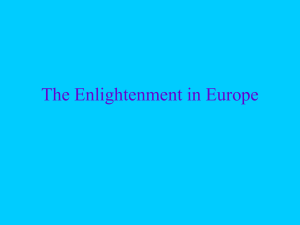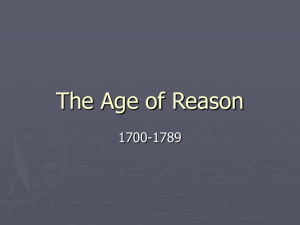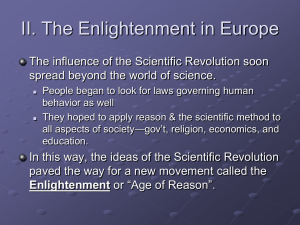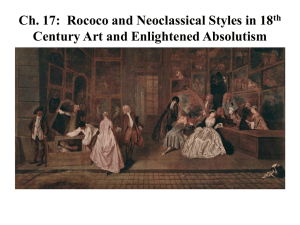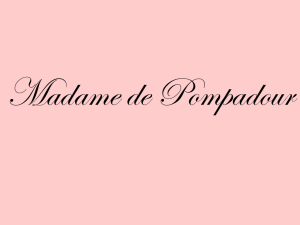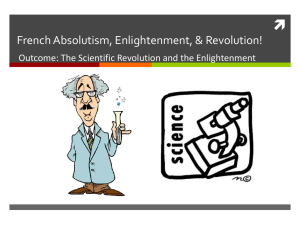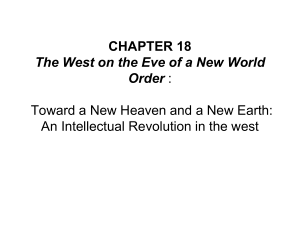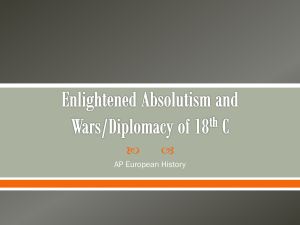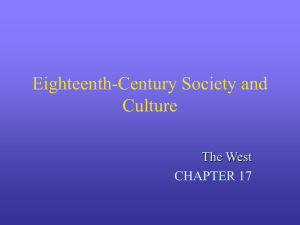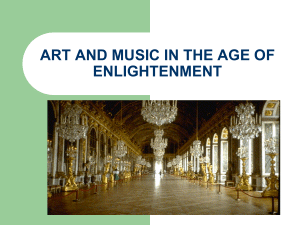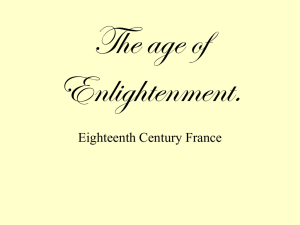Chapter Eleven Enlightenment and Rococo
advertisement
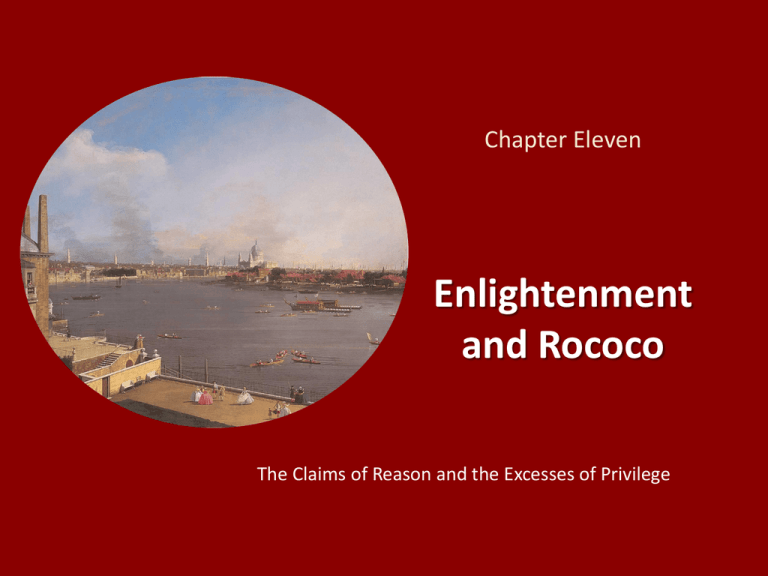
Chapter Eleven Enlightenment and Rococo The Claims of Reason and the Excesses of Privilege The English Enlightenment • After the Great Fire that devastated London in 1666, architect Christopher Wren proposed a grand redesign scheme that would have replaced the old city with wide boulevards and great squares • Although his plans to redesign the entire London city center proved impractical, he did receive the commission to build 52 of the churches destroyed in the blaze • His St. Paul’s Cathedral rises above them all, a complex yet orderly synthesis of the major architectural styles of the previous 150 years: classical Gothic, Renaissance, and Baroque Christopher Wren, St. Paul’s Cathedral 1675-1710 The New Rationalism and the Scientific Revolution • The new London was, in part, the result of the empirical thinking that came to dominate the Western imagination in the late seventeenth century • According to these new ways of reasoning, Scientia, the Latin word for “knowledge,” was to be found in the world, not in religious belief • The leading advocate of the empirical method in the seventeenth century was Francs Bacon, who, along with a group of men, formed “The Royal Society of London for Improving Natural Knowledge.” Their organization continues to this day as the Royal Society • As opposed to Bacon’s inductive reasoning, René Descartes proceeded to his conclusions by the opposite method of deductive reasoning The Scientific Revolution • Johannes Kepler, a German mathematician, had made detailed records of the movements of the planets, substantiating Copernicus’s theory that the cosmos was heliocentric (sun-centered), not geocentric (earthcentered) • Kepler’s friend Galileo Galilei had improved the design and magnification of the telescope • Dutch lensmaker Antoni van Leeuwenhoek was able to grind a lens that magnified 200 times, quite a jump from the earlier compound microscope that was able to magnify objects only about twenty or thirty times their natural size • Isaac Newton computed the law of universal gravitation in a precise mathematical equation, demonstrating that each and every object exerts an attraction to a greater or lesser degree on all other objects Joseph Wright, An Experiment on a Bird in the Air-Pump Oil on canvas, 6' 8', 1768 • Soon experiments demonstrating the laws of physics became a popular form of entertainment • This painting depicts a scientist depriving a white cockatoo of oxygen by creating a vacuum in the glass above the pump • The children are clearly upset by the bird’s imminent death The Industrial Revolution • From 1765 until 1815, a group of prominent manufacturers, inventors, and naturalists known as the Lunar Society met in and around Birmingham each month on the night of the full moon to discuss chemistry, medicine, electricity, gases, and any and every topic that might prove fruitful for industry • Many of their inventions and innovations launched the Industrial Revolution • Josiah Wedgwood pioneered a new production process for the manufacture of ceramic ware, greatly increasing the speed of production • The flying shuttle (John Kay), the water frame (Richard Arkwright), the steam engine (James Watt), and the use of coke to fire cast iron (Abraham Darby I and Abraham Darby III) revolutionized the textile and metalworking industries Absolutism Versus Liberalism: Hobbes and Locke • Following the Civil War led by Oliver Cromwell and the subsequent Restoration of a greatly disempowered monarchy, one of the most pressing issues of the day was how best to govern the nation • Thomas Hobbes argued in Leviathan that the people needed to submit to the authority of a ruler to prevent anarchy. The social contract gives up individual sovereignty in exchange for protection from depravity • John Locke argued that a ruler has limited authority; if the ruler fails to protect the people’s rights, then the people have the right to rebel and reclaim their freedom from government John Milton’s Paradise Lost • The debate between absolutism and liberalism also informs what is arguably the greatest English poem of the seventeenth century, Milton’s Paradise Lost • The subject of the poem is the Judeo-Christian story of the loss of Paradise by Adam and Eve and their descendents • However, it also clearly deals with the issues of rule and liberty outlined by Hobbes and Locke that were such divisive concerns of England in the seventeenth century Satire: Enlightenment Wit • The orderly society of George I and his prime minister, Robert Walpole, demonstrated what is probably the fundamental principle of Enlightenment thought—that social change and political reform were both desirable and possible • Thoughtful commentators who looked beneath the surface detected a cauldron of social ferment and moral bankruptcy—the “dark side” of the Enlightenment • Satirists like William Hogarth, Jonathan Swift, and Alexander Pope sought by means of irony and humor to return England to its proper path William Hogarth, Gin Lane Engraving and etching, 14" 11-7/8", 1751 • By 1743, thousands of Londoners were addicted to gin, their sole means of escape from a life of poverty • Hogarth emphasizes the reality of London at its worst • Hogarth recognized that his work appealed to a large popular audience, and that by distributing engravings he might make a comfortable living Jonathan Swift • Jonathan Swift was perhaps the most biting satirist of the English Enlightenment • After a modestly successful career as a satirist in the first decade of the eighteenth century, Swift in 1713 was named Dean of Saint Patrick’s Cathedral in Dublin • In Gulliver’s Travels (1726), which played off the travel adventure narrative, Swift commented on human behavior • Reacting to the terrible poverty he saw in Ireland, in the brief, almost fanatically savage A Modest Proposal (1729), Swift proposed that Irish families who could not afford to feed their children breed them to be butchered and served to the English Alexander Pope • A classical poet whose early work involved translating and editing Homer and Shakespeare, Pope became a wealthy man due to the popularity of his work • In 1727 he turned to satire, producing The Dunciad, which opens with a direct attack on King George II • Against what he believed to be the debased English court, in An Essay on Man (1732-1734) he argues for honesty, charity, selflessness, and the order, harmony, and balance of the classics • In the end, for Pope, humankind must strive for good, even if in its frailty it is doomed to fail Literacy and the Rise of the English Novel • By 1750, at least 60 percent of adult men and 50 percent of adult women in England could read • Although not invented in eighteenth-century England (Cervantes’s Don Quixote, written a century earlier, is considered the first novel in Western literature), novels flourished. Read by people of every social class, they claimed to be realistic portrayals of contemporary life and provided respite from the drudgery of everyday life, certainly a healthier addiction than drinking gin • Among the more popular novelists of that time were Samuel Richardson (Pamela), Henry Fielding (Shamela), Daniel Defoe (Robinson Crusoe, Moll Flanders), and Jane Austen (Pride and Prejudice) The Enlightenment in France • All hôtels, or Paris townhouses, of the French nobility had a salon, a room designed especially for social gatherings • These salons became the center of French culture in the eighteenth century, and by 1850 they were emulated across Europe • The most influential Parisian thinkers of the day, the so-called philosophes, frequented the salons and dominated the intellectual life of the French Enlightenment • Not philosophers in the strict sense of the word because they did not concentrate on matters metaphysical, the philosophes turned their attention to secular and social concern Germain Boffrand, Salon de la Princesse de Soubise Hôtel de Soubise, Paris, ca. 1740 The Rococo • The decorative style fostered by the French court in the eighteenth century and quickly emulated by royal courts across Europe was known as the Rococo • The term is thought to derive from the French rocaille, a type of decorative rockwork made from rounded pebbles and shells. But it also derives from barocco, the Italian word for “baroque” • Rococo is an artistic style in all media that is associated with decorative elaboration, employing S- and C-curves, shell, wing, scroll, and plant tendril forms, and rounded, convex, often asymmetrical surfaces The Fêtes Galantes • The fêtes galantes are paintings whose subject matter is generally gallant, amorous celebrations by elite groups in pastoral settings • Such works epitomize Rococo painting – Subject matter often frivolous – Generally asymmetrical – Color range is light, emphasizing gold, silver, and pastels • The Rococo found its most eloquent expression in France in the paintings of Jean-Antoine Watteau, ironic because he did not have aristocratic patrons and was little known during his lifetime beyond a small group of bourgeois buyers Jean-Antoine Watteau, The Embarkation from Cythera Oil on canvas, 50¾" 76-3/8", ca. 1718-1719 Madame de Pompadour • Madame de Pompadour was born into a middle-class family. A great defender of the philosophes, she was also mistress to Louis XV • She was the king’s trusted advisor and the subject of many erotic paintings done at court depicting her as Venus • Madame de Pompadour’s favorite artist was François Boucher, Watteau’s heir as master of fêtes galantes • Two views of Madame underscore the dual roles (intellectual and erotic) that she played in the French court François Boucher Madame de Pompadour The Toilet of Venus Oil on canvas, 79-1/8" 61-7/8", 1756 Oil on canvas, 42-5/8" 33-1/8", 1751 Jean-Honoré Fragonard • Jean-Honoré Fragonard, a student of Boucher, took Rococo principles into the next generation • His most famous work, The Swing, suggests an erotic intrigue between young lovers (supposedly emblematic of Louis XV and his mistress, Madame du Barry) • The composition permits the viewer to share, somewhat, the young man’s voyeuristic pleasure • Subtly, and ironically, the composition echoes the central panel of Michelangelo’s Sistine Chapel, the Creation of Adam. The male lover assumes Adam’s position, and the female lover God’s, although she reaches toward Adam with her foot, not her hand Jean-Honoré Fragonard, The Swing Oil on canvas, 32-5/8" 26“, 1767 The English Garden • Becoming popular in England beginning in about 1720, such gardens tried to imitate rural nature • Instead of the straight, geometrical layout of the French garden, the walkways of the English garden are “serpentine meanders” • Inspiration for such gardens was found in the writings of Roman authors and seventeenth-century landscape paintings by Claude Lorrain • These gardens, in turn, inspired the landscapes of Watteau’s fêtes galantes and Fragonard’s The Swing "Garden as Landscape" Video will play automatically. From Landscape: The Invention of Nature (length: 2:26). Item #36454 The Philosophes • Most philosophes were Deists, great believers in natural law and generally opposed to organized religion and monarchy • The philosophes had a simple proposition, stated plainly by Diderot: “Men will not be free until the last king is strangled with the entrails of the last priest” • Notable philosophes included Denis Diderot, Jean-Jacques Rousseau, and François-Marie Arouet (Voltaire) Jean-Baptiste-Siméon Chardin, A Philosopher Occupied with His Reading Oil on canvas, 54-3/8” 41-3/8”, 1734 Diderot and the Encyclopédie • The crowning achievement of the philosophes was the Encyclopédie, a 35-volume text, written between 1750 and 1772 by more than 180 writers. Its editors were Denis Diderot and Jean le Rond d’Alembert • It represents a fundamental principle of the Enlightenment: to accumulate, codify, and preserve human knowledge • The work was unpopular in the French court; Louis XV claimed that it was doing “irreparable damage to morality and religion” and twice banned its printing • Funded by 4,000 subscribers, the Encyclopédie was probably read by 100 times that number Rousseau and the Social Contract • Rousseau believed in the natural goodness of humankind, but also thought that goodness was corrupted by society and civilization • “Man is born free, and everywhere he is in chains” is the famous opening line of his work, The Social Contract, in which he describes an ideal state governed by a somewhat mystical “General Will” of the people • Rousseau was not a social being, even though his writings on social issues were among the most influential of the age. He ultimately withdrew from society altogether, suffering increasingly acute attacks of paranoia, and died insane Voltaire and French Satire • A voluminous writer in multiple genres, Voltaire, the pen name of François-Marie Arouet, was a witty, well-schooled, distinguished ornament to several courts, embodying his era for many • Even as he was supported by Louis XV and Frederick the Great, he satirized them and their courts, earning himself stints in prison or exile • Freedom of thought was most important to him, as seen in his most famous work, Candide, a prose satire based in part on the philosophical optimism of Alexander Pope’s Essay on Man Cross-Cultural Contact • The impact of the Enlightenment’s encounters with other cultures should not be underestimated • During the eighteenth century, China was still the largest empire in the world and, in many respects, it was more advanced than any society in the West and its people better educated • In India, religious tolerance supported a society in which Christians, Jews, Hindus, Buddhists, and others were invited to debate with Muslim scholars The South Pacific • Both Chinese and Indian cultures were relatively well known in Europe in the eighteenth century, but the South Seas remained unexplored • On August 26, 1768, Captain James Cook, sponsored by the Royal Society and the British Admiralty, set sail from Plymouth, England, for the South Pacific in order to chart the transit of Venus, the moment when the planet Venus crosses directly between the sun and the earth • The philosophes, notably Diderot, had argued that the natives of Tahiti were truly Rousseau’s “noble savages.” Cook, on his return, took exception to this picture, pointing out the highly stratified social hierarchy, the private ownership of island property, and the morally strict sexual lives of the Tahitians Francis Parkinson, Portrait of a Maori Wash drawing, 15½" 11-5/8", 1769 • One of the most distinctive art forms that Cook and his crew encountered in Polynesia was tattooing • The islanders believed that individuals were imbued with mana, a spiritual substance that is the manifestation of the gods on earth • A person might increase his or her mana by wearing certain items of dress, including tattoos Europe’s Chinoiserie Craze • By 1715 every major European trading nation had an office in Canton • Chinese goods—porcelains, wallpapers, carved ivory fans, boxes, lacquerware, and patterned silks—flooded the European markets, creating a widespread taste for what quickly became known as chinoiserie, meaning “all things Chinese” • Artists such as Boucher imitated the Chinese blue-on-white style in oil paint, and chinoiserie furniture was especially popular • The Chinese Pagoda in London’s Kew Gardens became a model for a whole new kind of garden architecture Chinoiserie Islamic India • The synthesis of indigenous art traditions with Western conventions is apparent in Indian art • The reason has much to do with the tolerance practiced by India’s Muslim leaders in the seventeenth and eighteenth centuries • A group known as the Moguls had established a strong empire, promoting a synthesis of religious and artistic traditions: Hindu art (and religion), Islamic art, especially influenced from Tabriz in Persia, and Western art • The British East India Company, which had exclusive trading rights in the East Indies, provided the force behind the growing interest in portraiture Bichitr, Jahangir Seated on an Allegorical Throne Watercolor, gold, and ink on paper, 10" 7-1/8", ca. 1625 • The Mogul ruler Jahangir, whose name means “World Seizer,” is seated between the two pillars • The stiff formality of the figures, depicted in profile facing left and right toward a central axis, make a sharp contrast to the variety of faces with different racial and ethnic features
